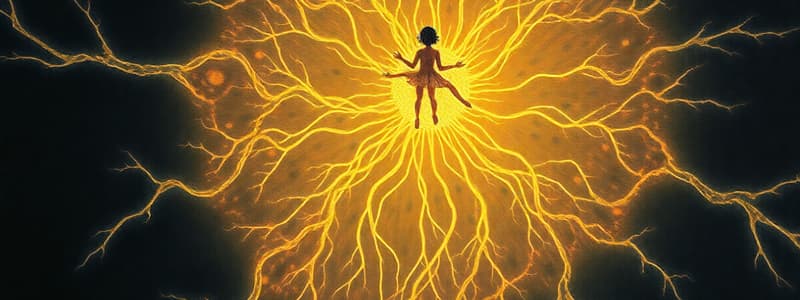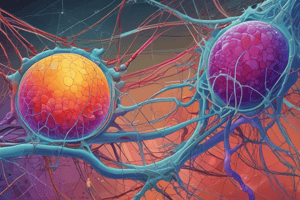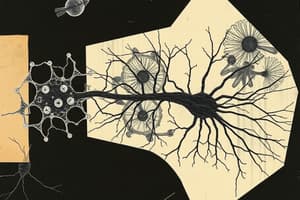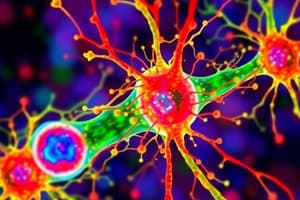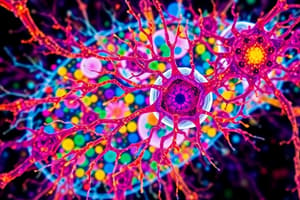Podcast
Questions and Answers
What role do kinesins and dyneins play in the cell?
What role do kinesins and dyneins play in the cell?
- They store sugar in the form of glycogen.
- They act as motor proteins to move organelles along microtubules. (correct)
- They form the structural component of the centrosome.
- They disassemble microtubules for cellular division.
Which of these best describes the structure of a centrosome?
Which of these best describes the structure of a centrosome?
- A network of microtubules connecting the nucleus and Golgi apparatus.
- A spherical structure containing a protein matrix and paired centrioles. (correct)
- A cluster of ribosomes involved in protein synthesis.
- A membrane-bound vesicle containing lipids and glycogen.
What is the main function of the centrosome matrix?
What is the main function of the centrosome matrix?
- To break down cellular waste products.
- To store glycogen for energy.
- To seed the growth and elongation of microtubules. (correct)
- To synthesize lipids required for the cell membrane.
What distinguishes the microtubules within centrioles from other microtubules in the cell?
What distinguishes the microtubules within centrioles from other microtubules in the cell?
Which of the following is NOT a characteristic of cytoplasmic inclusions?
Which of the following is NOT a characteristic of cytoplasmic inclusions?
What is the primary role of glycosomes in a cell?
What is the primary role of glycosomes in a cell?
How do lipid droplets differ from lysosomes in appearance?
How do lipid droplets differ from lysosomes in appearance?
What is the main difference in size and appearance between glycosomes and ribosomes?
What is the main difference in size and appearance between glycosomes and ribosomes?
Which of the following is NOT a function of the cytoskeleton?
Which of the following is NOT a function of the cytoskeleton?
What is the primary protein component of microfilaments?
What is the primary protein component of microfilaments?
Which cytoskeletal element is known for its high tensile strength and resistance to pulling forces?
Which cytoskeletal element is known for its high tensile strength and resistance to pulling forces?
What is the function of myosin in conjunction with microfilaments?
What is the function of myosin in conjunction with microfilaments?
Which cytoskeletal elements are composed of tubulin?
Which cytoskeletal elements are composed of tubulin?
What is the cellular structure that organizes microtubules?
What is the cellular structure that organizes microtubules?
Which of the following best describes the behavior of microfilaments, except in muscle cells?
Which of the following best describes the behavior of microfilaments, except in muscle cells?
The crawling action of a cell using extensions called pseudopods is known as:
The crawling action of a cell using extensions called pseudopods is known as:
Flashcards
What is the cytoskeleton?
What is the cytoskeleton?
A network of protein fibers that provides support and helps with movement within a cell.
What are the three main types of cytoskeletal elements?
What are the three main types of cytoskeletal elements?
Microfilaments, intermediate filaments, and microtubules.
What are microfilaments made of and what is their function?
What are microfilaments made of and what is their function?
Thin filaments made of the protein actin, involved in cell movement and division.
What is the role of myosin?
What is the role of myosin?
Signup and view all the flashcards
What are intermediate filaments and what is their function?
What are intermediate filaments and what is their function?
Signup and view all the flashcards
What are microtubules and what is their function?
What are microtubules and what is their function?
Signup and view all the flashcards
What is the centrosome?
What is the centrosome?
Signup and view all the flashcards
What is cytokinesis?
What is cytokinesis?
Signup and view all the flashcards
What are centrioles?
What are centrioles?
Signup and view all the flashcards
What is a centrosome?
What is a centrosome?
Signup and view all the flashcards
What are kinesins and dyneins?
What are kinesins and dyneins?
Signup and view all the flashcards
Why are microtubules considered dynamic?
Why are microtubules considered dynamic?
Signup and view all the flashcards
What are cytoplasmic inclusions?
What are cytoplasmic inclusions?
Signup and view all the flashcards
What are lipid droplets?
What are lipid droplets?
Signup and view all the flashcards
What are glycosomes?
What are glycosomes?
Signup and view all the flashcards
What is glycogen?
What is glycogen?
Signup and view all the flashcards
Study Notes
Cytoskeleton
- The cytoskeleton is a network of rods within the cytosol, supporting cell structures and enabling movements.
- It's composed of microfilaments, intermediate filaments, and microtubules.
- Microfilaments, made of actin, are the thinnest elements.
- They are concentrated beneath the plasma membrane and interact with myosin for contraction during cell division, endocytosis, exocytosis, and pseudopod formation (amoeboid motion).
- Actin microfilaments are unstable, constantly breaking down and reforming.
- Intermediate filaments are tough, insoluble protein fibers, with a diameter between microfilaments and microtubules.
- They have high tensile strength, resisting pulling forces and linking adjacent cells via desmosomes.
- Microtubules are the largest cytoskeletal elements, hollow tubes made of tubulin.
- Microtubules radiate from the centrosome, determining cell shape and organelle distribution.
- Organelles, such as mitochondria and lysosomes, move along microtubules via motor proteins (kinesins and dyneins).
- Microtubules are dynamic, constantly growing, disassembling, and reassembling.
Centrosome and Centrioles
- The centrosome is a non-membrane-bound structure near the nucleus, containing the centrosome matrix and a pair of centrioles.
- The matrix of protein seeds microtubule growth.
- Centrioles are barrel-shaped, perpendicular to each other, made of 27 microtubules arranged in nine sets of three.
- Centrioles are stable and involved in cilia/flagella formation, and the mitotic spindle.
Cytoplasmic Inclusions
- Cytoplasmic inclusions are temporary structures, not permanent organelles.
- Examples include pigments, protein crystals, and food stores.
- Food stores, lipid droplets and glycosomes, are crucial.
- Lipid droplets are spherical, stored fat usually lacking a membrane.
- Glycosomes are dense, spherical granules storing glycogen.
- Glycosomes contain enzymes for glycogen synthesis and degradation to glucose.
Studying That Suits You
Use AI to generate personalized quizzes and flashcards to suit your learning preferences.
